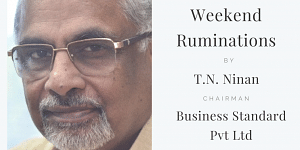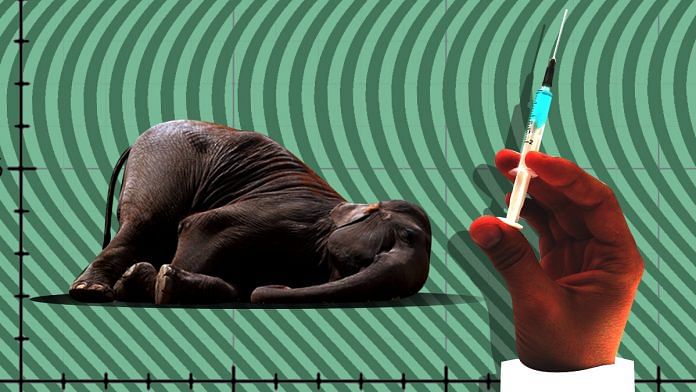The Vajpayee govt suppressed food prices and lost, while the first Manmohan Singh govt corrected that and was re-elected. It’s good politics and good economics.
The last couple of weeks have made three things clear. First, the economy is slowing. Following the release of the lower-than-expected July-September growth number for gross domestic product (GDP), most analysts have lowered their full-year growth forecasts. Some project second-half growth at under 7 per cent. The encouraging sign is a pick-up in investment, depressed so far, but that is overshadowed by flagging consumer spending. The Reserve Bank of India recognises this, but continues to project full-year growth at 7.4 per cent. Even that implies a second-half growth rate of only 7.2 per cent — no better than the unsatisfactory trend rate from 2014.
Second, the inflation rate has dipped more sharply than expected. The RBI targets 4 per cent inflation. The current rate has been below that for three months, and just 3.3 per cent for the latest month (October). The agricultural price inflation rate is lower still. The quarterly GDP numbers record a sharp deterioration in the terms of trade for agriculture. This explains why farmers are in such distress in many states, even as depressed rural wages have contributed to poor rural demand.
 And third, the full year’s fiscal deficit target was crossed by October-end. The government insists that it will stay within the full-year target of 3.3 per cent of GDP (down from 3.5 per cent in the last two years), but there is the growing possibility that it will be able to do so only by withholding payments that are due on various counts. In other words, it will be a fudge.
And third, the full year’s fiscal deficit target was crossed by October-end. The government insists that it will stay within the full-year target of 3.3 per cent of GDP (down from 3.5 per cent in the last two years), but there is the growing possibility that it will be able to do so only by withholding payments that are due on various counts. In other words, it will be a fudge.
The first two indicators (lower economic growth and below-target inflation) point to the need for an economic stimulus, especially when demand growth is slowing and there is spare capacity in the system. Yet the policy response has been anything but. The government continues to insist on sticking to fiscal contraction. The RBI on its part argues that it needs more time to understand price trends, and therefore has not lowered its policy rate of 6.5 per cent. This, despite a more than 3 percentage point gap between that and the current inflation rate. Both the government and the RBI should re-examine their positions.
Loan rates in the market are simply too high. HDFC’s home loan rates range from 8.8 per cent to 9.5 per cent, at a time when house prices are falling.
Naturally, housing demand is low. Most banks have a lending rate of over 9 per cent for their best customers. Small and medium enterprises borrow at much higher rates of interest. The effective borrowing rate for perhaps the majority of companies is more than their return on capital employed. That translates into “unaffordable”. Interest rates need to drop if there is to be broad-based economic revival.
Also read: On GDP, it’s time to construct an Indian version of the Li Keqiang index
On its part, the fiscal stance should be less rigid. The great danger in over-spending by the government is that it lets loose inflation, which becomes difficult to tame. That is not a serious danger today, when the inflation rate is below target and the danger of runaway oil prices has passed. There is therefore a legitimate case for arguing that the government should allow the deficit level to inch up to a more realistic 3.5 per cent of GDP, the same level as in the last two years. That will be a neutral, not expansionary, stance, easily justified in the current situation, and realistic since the deficit has already crossed the full year’s 3.3 per cent target in seven months.
Finally, there has to be a policy package to shore up agricultural prices, especially for crops with greater price volatility. The target to double agricultural exports is a start, but more needs to be done — and quickly. It is only when farmers get a better price that agricultural wages go up, reducing rural poverty and boosting rural demand. Politically, the Vajpayee government suppressed food prices and paid the price. The first Manmohan Singh government corrected that, despite the cost of higher inflation, and won re-election. So far, the Modi government has been repeating the Vajpayee mistake. Course correction today would be good politics and also good economics.
By Special Arrangement with Business Standard




Prof PK Sharma,Freelance Journalist,Barnala(Punjab)
The duo of NaMo- Amit Shah neither believe in good politics nor healthy sound economics !
That is why they are interested only in winning polls for pretty pretty long ?
They are not at all concerned about the progress, prosperity, development and advancement
of the nation. By centralising power in their hands, wishfully discarding and overlooking the
rich talent, expertise and calibre in the BJP and nation elsewhere their charm only is in pushing
forward their own vested selfish as well as self-centred, lust for endless power interests !
That is the reason, nation is facing the music on various fronts !
Prof PK Sharma,Freelance Journalist
Pom Anm Nest,Barnala (Punjab)
Late Vajpayee Bharat Ratna awardee did the right thing by keeping food prices low. I had nightmares during Singh’s tenure due to high food prices.
What Fiscal Deficit is the author talking about?What about US Dollars 140 Billion,in US Treasuries?
Prices were high due to international prices during manmohan era morever agriexports were also high.vajapee actually increase govt money from 80%of gdp to 120Of gdp by increasing fiscal defecit and printing cash.he spent entire saving of public sector unit which later help manmohan toreap Rich benefit. Modi is doing exactly opposite govt money has fallen to60%of gdp and India is headed for major crisis.
Fiscal stance should be less rigid … It feels like marshmallow to me. An oil bonanza of possibly twelve trillion has been absorbed by Centre and states without leaving a trace. Enduring mystery what happens to our tax revenues. Growth has been slowing for a lot more than a few months. Difficult to figure what the correct number is, though. If the economy becomes a make or break issue in the general election – as exit polls suggest it has been for the Hindi heartland states – it will not be because of fiscal or monetary hawkishness. It has been comprehensively mismanaged all through, with demonetisation and GST the most visible missteps. Not much left in Santa Claus’ sack to give away in the next three months. Hopefully, there will be no reckless moves, like relieving the RBI of its unearned profits to fund some KCResque giveaways.
The Oil bonanza had to be used because the economist Prime minister left a big hole in the Fiscal Math by postponing the payments to Oil companies for the subsidy that the Govt gave to people when oil prices were high. If people are willing to pay high oil prices without cribbing the fisc and consequently the taxes will also come down